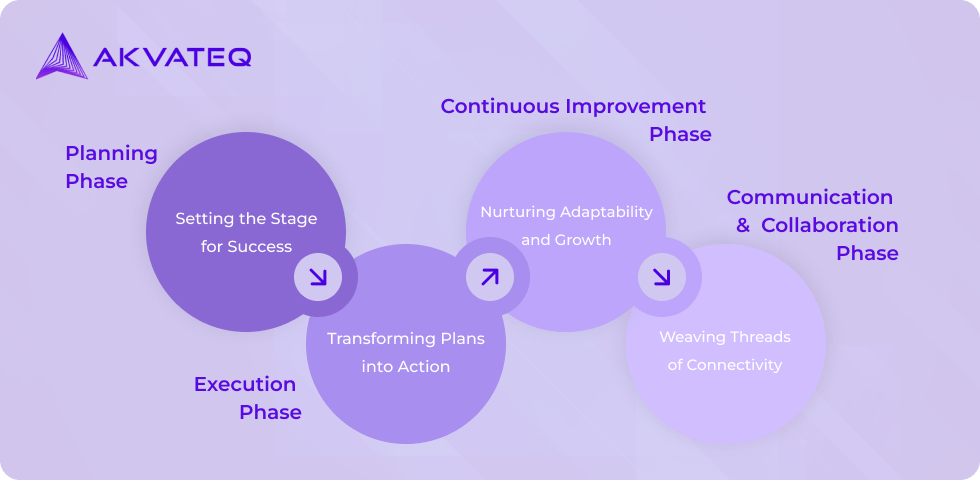In the fast-paced world of business, ensuring the quality of your software products or services is crucial. For software industry entrepreneurs looking to optimize their processes, adopting an Agile Quality Assurance (QA) approach is a game-changer. Agile QA involves a dynamic and collaborative method to ensure the quality of your project at every step. To make this concept more accessible, we’ve compiled the 12 best practices for an Agile QA process that entrepreneurs can implement for smoother and more efficient project development.
Now, let’s delve into each practice to understand how it contributes to a successful Agile QA process.
What Is an Agile Process?
Before diving into the best practices, let’s grasp the essence of an Agile process. In simple terms, Agile is a flexible and iterative approach to software project management and software product development. It focuses on collaboration, customer feedback, and small, rapid releases.
Imagine your project as a jigsaw puzzle. Instead of waiting for all the pieces to fit perfectly, Agile breaks the puzzle into smaller, more manageable parts. Each part is like a mini-puzzle, allowing your team to make improvements and adjust based on feedback from users or stakeholders. This cycle happens over and over, making sure your project can quickly adapt to changes in requirements. Agile isn’t just a set of rules; it’s a way of thinking that welcomes change and teamwork to deliver really good results. Now, let’s see how we can use Agile ideas in the QA process to be super efficient and effective.
get in touch to discuss your project
Advantages and Disadvantages of Agile
Embracing an Agile QA process comes with its set of advantages and disadvantages. Let’s start with the positives.
Advantages
In the world of entrepreneurial endeavors, embracing an Agile QA process brings forth a host of advantages that can significantly impact your project’s success.
- Enhanced Adaptability: Agile methodologies provide a framework that allows your team to swiftly adapt to changing project requirements and priorities.
- Customer-Centric Approach: Regular collaboration and feedback loops ensure that your product aligns closely with customer expectations, leading to higher satisfaction.
- Efficient Resource Utilization: By breaking down the project into smaller iterations, Agile optimizes resource allocation, ensuring maximum efficiency.
- Faster Time-to-Market: The incremental and iterative nature of Agile results in quicker releases, allowing you to get your product into the market faster than traditional approaches.
- Higher Quality Deliverables: Continuous testing and quality assurance integrated into the SaaS development process ensure that the end product meets high standards.
For software industry entrepreneurs aiming for success in a dynamic market, leveraging these advantages through an Agile QA process is a strategic move that can positively impact project outcomes. Now, let’s explore how to navigate the challenges that may arise.
get in touch to discuss your project
Disadvantages
While the advantages of an Agile QA process are compelling, it’s equally important for software developers to be aware of potential challenges that may arise.
- Active Team Participation Requirement: Implementing Agile necessitates active involvement from all team members, demanding consistent collaboration and contribution.
- Learning Curve: The initial transition to Agile practices may pose a learning curve for your team, requiring time and commitment to fully embrace the new methodology.
- Dependency on Customer Availability: Agile heavily relies on regular feedback from customers. Delays or unavailability of customers can impede the progress of the project.
Despite these challenges, understanding and addressing them proactively can lead to a more successful implementation of Agile QA processes. Now, let’s explore the specific phases that constitute an Agile process and how to navigate them effectively.
Four Phases of Agile

In the QA process, projects are divided into four distinct phases, each serving a crucial purpose in ensuring the success of your endeavor.
1. Planning Phase: Setting the Stage for Success
Agile planning is a pivotal initial step that lays the groundwork for a triumphant project. In this phase, the focus is on meticulously defining overarching goals, outlining specific tasks, and establishing realistic timelines. The Planning Phase essentially forms the bedrock of the entire project lifecycle, providing a comprehensive roadmap for the team to follow.
2. Execution Phase: Transforming Plans into Action
With the strategic plan in place, the Execution Phase takes center stage. This is when the development team gets involved in the project, making things happen in small, doable steps called sprints. In the Execution Phase, the ideas on paper turn into real results, pushing the project forward step by step.
3. Continuous Improvement Phase: Nurturing Adaptability and Growth
Synonymous with adaptability, Agile thrives on continuous improvement. In this phase, we regularly look at how things are going, figure out where we can make them better, and make changes to improve how things work. The Continuous Improvement Phase is like a continuous loop, always adjusting to keep up with any changes in what we need to do and how things are in the industry.
4. Communication & Collaboration Phase: Weaving Threads of Connectivity
Effective communication and collaboration form the backbone of Agile methodology. In this crucial phase, emphasis is placed on maintaining open lines of communication within the team and fostering a collaborative environment with stakeholders. The Communication and collaboration Phase ensures that insights are shared seamlessly, feedback is actively exchanged, and the entire team moves forward in unison toward project success.
Understanding these four phases is essential for software developers looking to implement Agile QA practices successfully. Now, let’s delve into each phase and explore the best practices associated with them.
Planning
In the Agile QA process, the planning phase serves as the bedrock for project success. Here are key components to consider during this crucial stage:
Include Quality Assurance from the Beginning:
To ensure a seamless Agile QA process, it’s vital to integrate quality assurance right from the planning phase. QA experts collaborate with the development team to understand project requirements, identify potential challenges, and establish testing criteria. This early involvement sets the stage for a proactive approach to quality.
Work Together on Identifying Issues:
Collaboration is key in agile planning. The entire team, including QA professionals, developers, and stakeholders, should actively participate in identifying potential issues and roadblocks. This collective effort ensures that all perspectives are considered, minimizing the chances of overlooking critical aspects.
Develop Agile Test Cases:
Creating test cases tailored to the agile methodology is paramount. Agile test cases should align with the iterative nature of the development process. These test cases not only verify functionality but also contribute to the ongoing refinement of the project.
By incorporating these practices into the planning phase, IT entrepreneurs set the groundwork for a more robust and quality-focused Agile QA process. Now, let’s transition to the next phase: Execution.
Execution
As your project moves into the execution phase in the Agile QA process, several key practices ensure a smooth development cycle:
Test Each Iteration:
In Agile, development occurs in iterations or sprints. For effective QA, it’s crucial to conduct testing at the end of each iteration. This approach allows for the early detection of issues, promoting a continuous improvement cycle and preventing the accumulation of potential problems.
Detect and Report Defects:
QA professionals play a vital role in identifying defects or issues within the product. Prompt detection and reporting enable the development team to address these concerns swiftly. This collaborative approach ensures that the final product is polished and refined.
Work Together for Issue Resolution:
When defects are identified, the QA team needs to collaborate with developers for resolution. This joint effort fosters effective communication and problem-solving, ensuring that issues are not just addressed but also used as learning opportunities for future iterations.
By incorporating these practices into the execution phase, entrepreneurs can maintain a dynamic and responsive approach to project development in the Agile QA process. Next, let’s explore the phase of Continuous Improvement.
Continuous Improvement
In the Agile QA process, continuous improvement is a pivotal phase where ongoing refinement leads to enhanced project outcomes. Here are key practices for software developers to embrace during this crucial stage:
Periodically Review the QA Process:
Regularly reviewing the QA process is integral to agile success. This involves assessing the effectiveness of testing strategies, identifying areas for improvement, and making adjustments to optimize the overall QA workflow. Periodic reviews ensure that the process evolves alongside the project.
Incorporate Feedback from Stakeholders:
Stakeholder feedback is a valuable asset in Agile. Actively seek input from stakeholders, including end-users and clients, to gather insights into their expectations and experiences. This collaborative approach ensures that the final product aligns closely with user needs.
Integrate Automation Testing:
Automation testing streamlines repetitive tasks, allowing the QA team to focus on more complex and nuanced aspects of the project. Integrating automation testing into the continuous improvement phase enhances efficiency, accelerates testing cycles, and contributes to overall project agility.
By adopting these practices in the continuous improvement phase, entrepreneurs pave the way for a more adaptive, efficient, and customer-centric Agile QA process. Now, let’s shift our focus to the critical aspect of Communication and collaboration.
Communication and Collaboration
Effective communication and collaboration are the lifelines of a successful Agile QA process. Here’s how software entrepreneurs can foster these crucial elements throughout their projects:
Emphasize Team Communication:
In the Agile environment, open and consistent communication among team members is paramount. Motivate team members to consistently communicate updates, confront challenges, and share valuable insights. This ensures that everyone is on the same page, fostering a collaborative and transparent work culture.
Daily Scrums:
Daily Scrums, or stand-up meetings, are brief gatherings where team members discuss progress, challenges, and plans for the day. These short, focused interactions promote real-time problem-solving and keep the team aligned with project goals. It’s a quick and effective way to maintain communication flow.
Promote Collaboration and Teamwork:
Agile thrives on collaboration. Entrepreneurs should actively promote a culture of teamwork, where developers, QA professionals, and other stakeholders collaborate seamlessly. Shared goals and a sense of collective ownership contribute to a more cohesive and efficient project execution.
By prioritizing communication and collaboration in the Agile QA process, entrepreneurs lay the foundation for a harmonious and productive team dynamic. Now, let’s explore the tangible benefits that arise from implementing these best practices.
get in touch to discuss your project
Benefits of Implementing Best Practices for an Agile QA Process
When we adopt and use the best methods in the Agile QA process. It not only creates a strong plan but also brings a lot of good things for entrepreneurs who want their projects to be efficient and excellent. Let’s look at the many advantages that come from following these best practices:
- Increased Adaptability:
Agile practices help your team easily handle and quickly adjust to changes. This ensures that your project stays important and matches the changing needs and fast-moving nature of the market. Being able to adapt like this is a big advantage in a business world that is always changing.
- Enhanced Product Quality:
Continuously testing and working together in an agile way helps make things good. This careful approach makes sure that what we create not only meets what customers want but often goes beyond, building a reputation for making excellent stuff.
- Faster Time-to-Market:
Agile helps us release things faster, giving our product a competitive advantage by getting it to customers quicker than usual. This speedy process is important for taking advantage of opportunities and staying ahead of other businesses in today’s fast-paced world.
- Improved Customer Satisfaction:
Getting feedback regularly is a key part of Agile practices. It helps make sure that what we make always meets what customers want. This ongoing feedback process not only makes customers happy but also builds their loyalty by showing we’re always trying to get better by using their valuable suggestions.
- Optimized Resource Utilization:
Agile puts a lot of focus on developing things in small steps, which helps us use our time and manpower wisely. This smart way of managing resources makes us more productive and reduces waste, making the whole project work better.
- Proactive Issue Resolution:
Catching and fixing problems early is a big part of Agile. It stops big issues from piling up, making sure our project goes smoothly. This way, we deal with challenges right from the start, so things don’t get messed up, and the project keeps moving forward smoothly.
- Continuous Improvement Culture:
As we work on projects in Agile, we make sure to review things often and ask for feedback from those involved. This helps us create a strong culture of always getting better. We keep changing and improving our methods as the project goes on, making a flexible and dynamic environment that can handle any new challenges or chances that come up.
Implementing these best practices not only mitigates challenges but also positions your project for sustained success in the ever-changing business landscape. Now, let’s wrap up our exploration with a concise conclusion.
Conclusion
In the dynamic realm of project development, adopting an Agile QA process is more than just a methodology; it’s a strategic approach for entrepreneurs aiming for success. The 12 best practices outlined in this article provide a roadmap for integrating Agile principles seamlessly into your projects.
By understanding the advantages and disadvantages of Agile, navigating the four phases, and implementing specific practices in planning, execution, continuous improvement, and communication, entrepreneurs can foster a culture of adaptability, collaboration, and quality assurance.
The benefits of such an approach are profound – increased adaptability to market changes, higher product quality, faster time-to-market, improved customer satisfaction, optimized resource utilization, proactive issue resolution, and a continuous improvement mindset. As you embark on your agile journey, remember that the key lies not just in following these best practices but in embracing the agile mindset of flexibility, collaboration, and continuous improvement. By doing so, you position your projects for success in the ever-evolving landscape of business. May your agile endeavors be fruitful, and dynamic, and bring lasting value to your ventures.



















